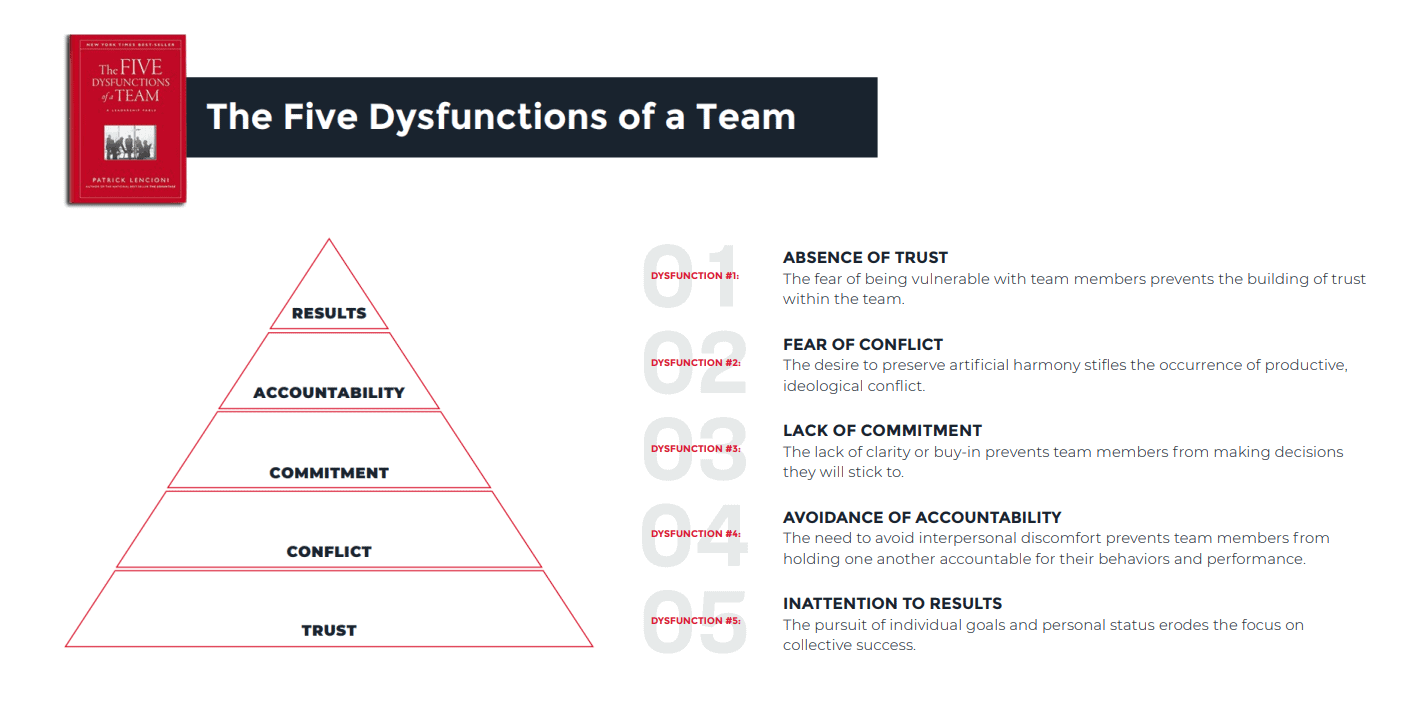
5 dysfunctions of a team in the context of Scrum values
I believe we all ask ourselves this question from time to time: how to build a well-integrated and efficient team that is able to solve the clients’ problems, at the same time enjoying the time spent together? After all, team members spend most of the day in each other’s company.
The Scrum methodology, which we often apply in our project, doesn’t state directly how to achieve this, although it does emphasise the role of a self-organising team in the product development process.
In this article, I draw on the book The Five Dysfunctions of a Team by Patrick Lencioni to compare his insights with the values promoted in the Scrum Guide and to find out which properties of Agile teams support product development.
One of the most popular concepts describing difficulties faced by teams is outlined in The Five Dysfunctions of a Team by Patrick Lencioni. Lencioni presents five interrelated areas which determine the effectiveness of a group.
According to the author, the critical area which constitutes the foundation of a healthy team is trust. It can be expressed in the team members’ openness to each other. In particular, it manifests itself in their readiness to expose their weaknesses and mistakes. For Lencioni: Trust is the belief in the good intentions of other people in the team. What follows is that the team members don’t need to be overly cautious and they don’t develop unhealthy defence mechanisms. When they feel safe, they can focus on their goals and tasks. They have no problem asking for help and they are more likely to take risks.
When the values of commitment, courage, focus, openness, and respect are embodied and lived by the Scrum Team, the Scrum pillars of transparency, inspection, and adaptation come to life and build trust for everyone.Patrick Lencioni “The Five Dysfunctions of a Team”
This is where we go to back to the Scrum Guide. Although it isn’t focused on teambuilding as such, there is a clear analogy. The values that form the basis for teamwork are enumerated here:
1. Build Trust
Scrum’s response to Lencioni’s trust is openness understood as readiness to communicate freely in terms of tasks and challenges faced by the team as well as to accept feedback, even if it’s difficult. Another value mentioned in the Scrum Guide is respect shown to other people on the team, regardless of their experience, background, and, most of all, the differences in the ways of acting and thinking.
2. Master conflict
Another pillar of teamwork described by Lencioni is the approach to conflict. Conflict is not understood here in its regular negative meaning. It means a discussion, an exchange of arguments, presentation of various poins of view.
One of Scrum values is courage defined as readiness to do the right thing, take risks, and solve difficult problems. In my opinion, courage, accompanied by the above-mentioned openness and respect, is what is needed to overcome the fear of conflict.
3. Achieve Commitment
The third area identified by Lencioni is commitment, especially when it comes to taking decisions and planning future actions together. The team members who don’t share their views in debates (perhaps because they are afraid of conflict) might find it difficult to be committed to the performance of a project, even if they seemingly agree with the team’s ideas. Speaking up for yourself to share your ideas, doubts, and fears reinforces the feeling of the team that the decision is taken collaboratively, which makes it easier to relate to and translate into action.
Scrum also refers to commitment as an important value. It is presented as personal dedication to acting as best as possible for achieving the goals of the team.
4. Embrace Accountability
The fourth area is accountability: assuming the responsibility for the team’s work both by personal engagement and, above all, by pointing to the behaviours of other team members which have a negative impact on the group in general. This way, the team is able to react to problems quickly and smoothly, following high standards and preserving the atmosphere of mutual trust.
What about Scrum? Let’s refer to openness again: being open to both receiving and giving feedback. One of the concepts underpinning Scrum is empiricism: working in an experience-based manner and learning from mistakes.
5. Focus on results
The final level of Lencioni’s pyramid is attention to results. In theory, it seems obvious that teams are built to respond to particular needs, but some members tend to concentrate on being in the group as such or on their private interests. Powerful teams avoid distraction and they focus on their common goals.
The corresponding Scrum value is focus, which means basically the same: making sure the team meets the goals set, which may be related to the client’s or user’s satisfaction. When teams base their work on priorities and collective goals, they are able to optimise their strength and deliver value.
How to use this knowledge in practice?
To my mind, working on raising awareness of the team leader and team members is enough to bring positive outcomes. It’s a good idea to think about which value is not sufficiently distinct in the team. Or, on the other hand, perhaps one of the dysfunctions described above is noticeable in the team’s work?
Another starting point for analysis is the set of questions developed by Lencioni:
- Do team members openly and readily disclose their opinions?
- Are team meetings compelling and productive?
- Does the team come to decisions quickly and avoid getting bogged down by consensus?
- Do team members confront one another about their shortcomings?
- Do team members sacrifice their own interests for the good of the team?
When you find the areas for improvement in your team, listen to the Manager Plus podcast, where Mariusz Chrapko suggests exercises for particular dysfunctions.
To learn more on this subject, take a look at these:
- The Five Dysfunctions of a Team – the book has a form of a business story, which I find really satisfying
- Scrum Guide – I guess it doesn’t need an introduction
- An article about the Scrum values
- Sample exercises for teams – they will help the team in getting to know the Scrum values
- Lencioni’s resources to accompany the book
- Mariusz Chrapko’s podcast – episodes 97–101 about the dysfunctions of teamwork (in Polish)





